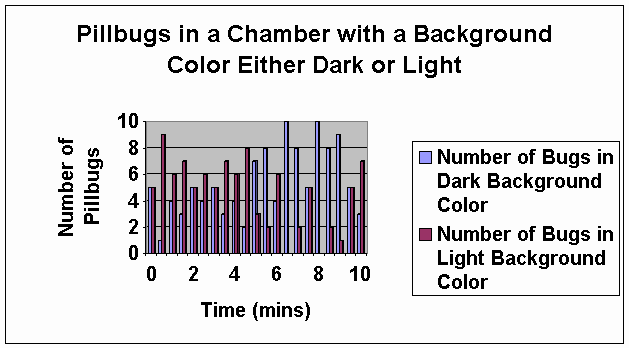Lab 11 Animal Behavior

Introduction:
Ethology is the study of animal behavior. An animal’s behavior is its response to sensory input. There are three types of behaviors: orientation, agonistic, and mating.
Orientation behaviors take the animal to its most favorable environment. Taxis is when an animal moves toward or away from a stimulus. Taxis is often characterized by light, heat, moisture, sound, or chemicals. Kinesis is another type of movement that involves orientation. Kinesis is a movement that is random and doesn’t involve a stimulus. So an animal would respond to light by moving everywhere in random directions.
Agonistic behavior is when animals respond to each other in aggressive or submissive movements. Like the hair on dogs backs when they get ready to fight. Another excellent example is the Betta fish, which is sometimes studied in labs.
Mating behaviors are activities that involve finding, courting, and mating with a member of the same species. An example would be a peacock fluffing up its feathers to attract females.
Hypothesis:
Pill bugs will prefer the wet side to the dry side of the petri dishes because they are used to living in dark moist conditions, such as under rocks or in rotting trees.
Materials:
Materials used in this experiment involved: a double petri dish combination, 10 pillbugs, bedding material, scissors, pencils, 2 pieces of filter paper, a piece of black construction paper, and a watch.
Methods:
Place 10 pillbugs in the petri dishes along with a little bedding material in each container. Observe them for about 10 minutes noting any observations that are characteristic to the bugs. Once that is done, take a piece of filter paper and soak it in water, then put the wet piece in the bottom of one of the containers. Put the other dry paper in the bottom of the other container. Put 5 pillbugs on each side and count how many bugs there are on each side every 30 seconds for 10 minutes.
Our designed experiment involved the same methods except substituting filter paper with a piece of black construction paper. Cut out the circular paper from a sheet of black paper and put it in one of the containers along with some bedding material. Place 5 pillbugs on each side and count how many there are on each side every 30 seconds for 10 minutes.
Results:
Table 11.1
| Time (mins) | Number in wet Chamber | Number in dry Chamber |
| 0 | 5 | 5 |
| .5 | 9 | 1 |
| 1.0 | 8 | 2 |
| 1.5 | 8 | 2 |
| 2.0 | 9 | 1 |
| 2.5 | 10 | 0 |
| 3.0 | 9 | 1 |
| 3.5 | 7 | 3 |
| 4.0 | 9 | 1 |
| 4.5 | 9 | 1 |
| 5.0 | 8 | 2 |
| 5.5 | 7 | 3 |
| 6.0 | 9 | 1 |
| 6.5 | 7 | 3 |
| 7.0 | 7 | 3 |
| 7.5 | 7 | 3 |
| 8.0 | 8 | 2 |
| 8.5 | 9 | 1 |
| 9.0 | 7 | 3 |
| 9.5 | 8 | 2 |
| 10.0 | 9 | 1 |

Table 11.2
| Time (Mins) | Number in wet Chamber | Number in dry Chamber |
| 0 | 5 | 5 |
| .5 | 9 | 1 |
| 1.0 | 6 | 4 |
| 1.5 | 7 | 3 |
| 2.0 | 5 | 5 |
| 2.5 | 6 | 4 |
| 3.0 | 5 | 5 |
| 3.5 | 7 | 3 |
| 4.0 | 6 | 4 |
| 4.5 | 8 | 2 |
| 5.0 | 3 | 7 |
| 5.5 | 2 | 8 |
| 6.0 | 6 | 4 |
| 6.5 | 0 | 10 |
| 7.0 | 2 | 8 |
| 7.5 | 5 | 5 |
| 8.0 | 0 | 10 |
| 8.5 | 2 | 8 |
| 9.0 | 1 | 9 |
| 9.5 | 5 | 5 |
| 10.0 | 7 | 3 |

1. What conclusion do you draw from your data? Explain physiological reasons for the behavior observed in this activity.
– The bugs preferred it in the wet conditions. They probably like it there because they live in place like that, under rocks or in trees or just in the soil. That is probably the only way they can keep cool and obtain moisture.
2. Obtain results from all lab groups in your class. With respect to humidity, light temperature, and other environmental conditions, which types of environment do isopods prefer? How do the data support these conclusions? Give specific examples.
– Our class didn’t exchange data with each other.
3. How do isopods locate appropriate environments?
– They use their antennae for a lot of their locating. One thing that I observed was they did use their antennae when they were walking around. They probably don’t have very good eyesight.
4. If you suddenly turned a rock over and found isopods under it, what would you expect them to be doing? If you watched the isopods for a few minutes, how would you expect to see their behavior change?
– I would expect them to scurry around, probably find and tunnel and go down it to keep out of the sunlight. If you found one that wasn’t already underground, I would probably see it walking out in the grass, looking for another object to go under.
5. Is the isopod’s response to moisture best classified as kinesis, or taxis? Explain your response.
– I think it’s best classified as kinesis because they moved around in random directions. Some of them just sat there while the others were moving around.
1. Select one of the variable factors above, and develop a hypothesis concerning the pillbug’s response to the factor.
– Background Color- I hypothesize that the pillbugs will prefer the dark background color over the light background color because they are used to living in dark places for most of their lives.
2. Use the material available in your classroom to design an experiment. Remember that heat is generated by lamps.
A) State the objective of your experiment.
– To see if background color has anything to do with behavioral responses in pillbugs to their environment.
B) List the materials you will use.
– Scissors, black construction paper, pillbugs, petri dish containers, and bedding material, as well as a watch.
C) Outline your procedure in detail.
– Our designed experiment involved the same methods as the real experiment except substituting filter paper with a piece of black construction paper. Cut out the circular paper from a sheet of black paper and put it in one of the containers along with some bedding material. Place 5 pillbugs on each side and count how many there are on each side every 30 seconds for 10 minutes.
Error Analysis:
Not many things could have drastically changed our results. All we had to do was to watch them and watch the time. If the bugs were forced into one of the chambers then that could have changed our results. Also if we hadn’t had kept a good time method then we could have been lost.
Conclusions:
The bugs like it in the wet environment because that is what it’s used to. It’s an easy way to get water and stay cool in their environment. They also liked the dark background because, again, that is what they are used to in their environment, under rocks or other things.
